Do you have some trees on your property that seem sick? You might need to learn how to identify borer beetles in trees. These insects lay their eggs inside of trees, where the larvae eat their way through the bark and wood.
How to get rid of borer beetles in trees? To get rid of borer beetles in trees, you want to choose a quality insecticide. However, trees that have many holes in them are usually easier to replace than to treat. Once borers get into trees, the non-chemical options you have are limited. Killing the bugs stops them from infesting other trees.
You can protect uninfected trees with some additional care. These pests are attracted to trees that have open injuries, such as ones from pruning. Keep reading this article to learn all the best ways to control borer beetles and protect your property.
What Are Wood-Boring Insects? | Tree Borer Beetles
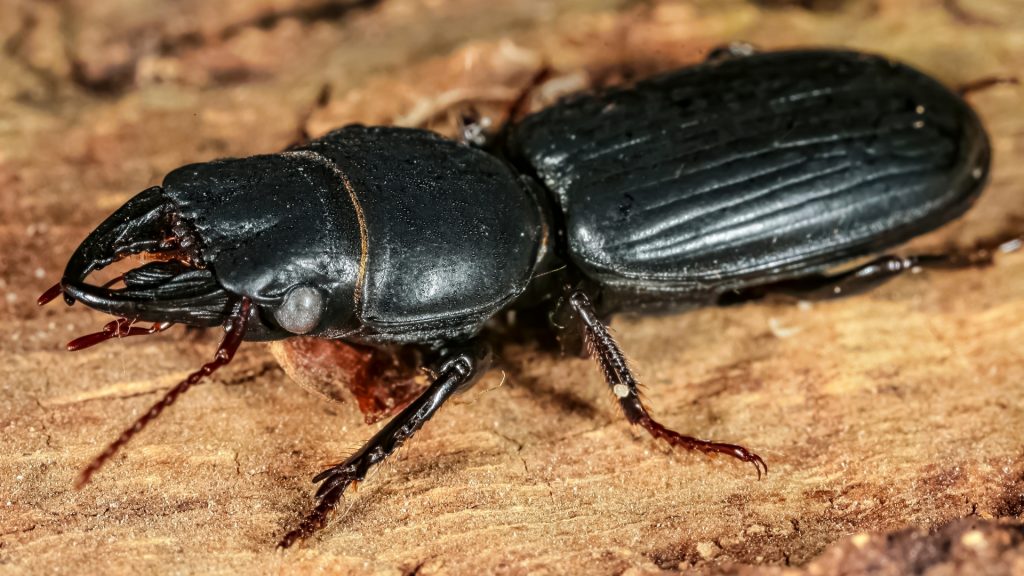
Tree borers are a collection of insects that lay their eggs inside or on trees, where the hatching larvae can eat their way through the tree’s wood. They are the most common insect of this type.
The borer can cause the trees to weaken as they chew holes through them, making it harder for the trees to transport materials internally. These tunnels will continue to weaken the tree over time.
The most common signs of these borer insects are the tiny holes in your trees. But you may also notice the sawdust that drops to the ground below where the bugs dig through the wood.
Related: How to Get Rid of Termites in Trees? | Information And Control Guide
Types of Tree Borer Beetles
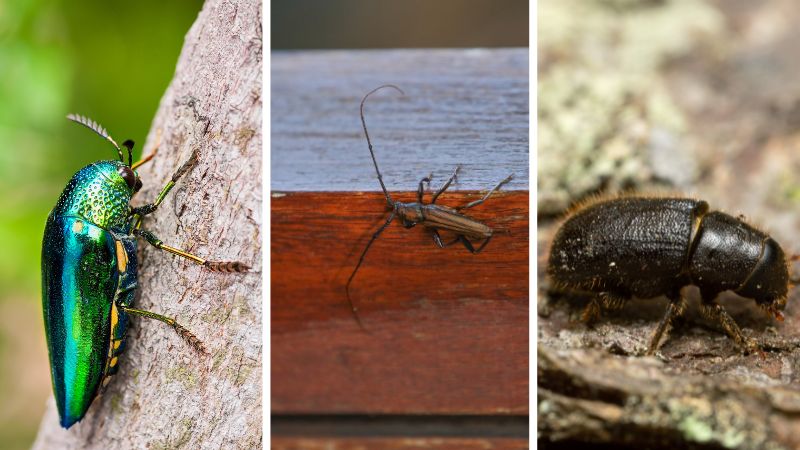
- Flat-headed Wood Borers (Buprestidae spp.). Also referred to as jewel beetles, these group of tree-boring insects attack recently moved trees or ones that are stressed. Adults have a shine to them, while the larvae’s flat shape allows them to make flat-looking holes when they dig tunnels through trees.
- Round-headed Borers (Cerambycidae spp.). These bugs grow into the longhorn beetle. They leave frass (a sawdust-like waste) around the bases of trees. Additionally, weevils will target the roots of trees, while wood-boring moth caterpillars will burrow into wood to avoid insecticides.
- Bark Beetles (Scolytinae spp.). Although they are common pests to a lot of tree species, they prefer attacking pines and other conifers. They damage trees that are already stressed by mechanical damage, disease, or drought. The larvae feed on bark found on branches and trunks, hence their common name. They bore holes which can exude tree dust or sap.
Related: Powderpost Beetle | Identification, Habitat, and Behavior
What Sections of the Tree Do Borer Beetles Attack?
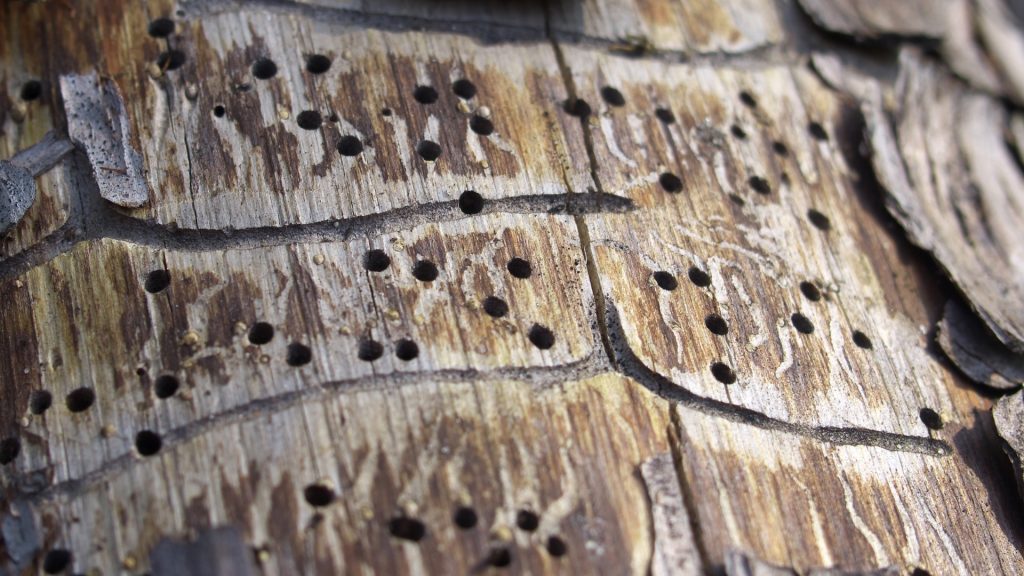
Most species of borer beetles will attack the trunks and branches of trees. They generally seek out trees that are already stressed and weak, so they can enter them easier.
When it comes to the species of trees, many beetles are not picky. They can infest cedar, pine, fir, and spruce trees. Some borer beetles specifically seek out fruit and redwood trees. Still, any and all weakened trees are targeted.
If your trees have borer beetles, you will notice:
- Trees release more pitch and sap
- Frass or sawdust is present
- The bark is falling off
- Small holes in the tree
- Woodpeckers are more interested in the tree
- The tops of the trees are turning red or brown
You will want to monitor your trees for these signs actively. Once the tree appears to show signs of dying, it is too late to save it. The best option is to spray the trees regularly with chemicals to prevent beetles from laying their eggs in the wood.
Keep in mind that chemical treatments can kill beneficial insects as well. You will want to find a nice balance between using the sprays and allowing the trees to recover.
How To Get Rid of Borer Beetles in Trees? | Tree Borer Treatment
Borer Beetle Insecticides
One of the best ways to kill borers in trees is to use a high-quality borer beetle insecticide. We recommend you try the Ortho Tree & Shrub Fruit Tree Spray; it’s great for protecting fruit trees on your property and is best used as a preventive measure.
- Controls insects, diseases and mites
- Kills insect stages, including eggs, larvae and adult. Controls...
- Can be used up to day of harvest
- Prevents fungal attack of plant tissues
- For use on fruit and nut trees and ornamentals
How To Treat Oak Tree Borers?
- Start by removing all infected parts of the tree and burning them. This process kills all the borrowing larvae as well as any unhatched eggs.
- Afterwards, use a borer spray on the tree’s trunk, branches, and bark. Spray it where you can see borer activity to kill most of them and slow their progress through the tree.
- Once you kill the active borers with the spray, you will want to continue giving the tree additional care. Give it more fertilizer, water, and treat it with the borer spray often.
- If there are unhatched eggs in the tree, continuing the treatment ensures you kill them as soon as they hatch.
Sadly, you won’t be able to save heavily infested trees. Instead, you will need to remove them as soon as possible to help prevent the infestation from spreading through your property.
How To Treat Trees With Emerald Ash Borer?
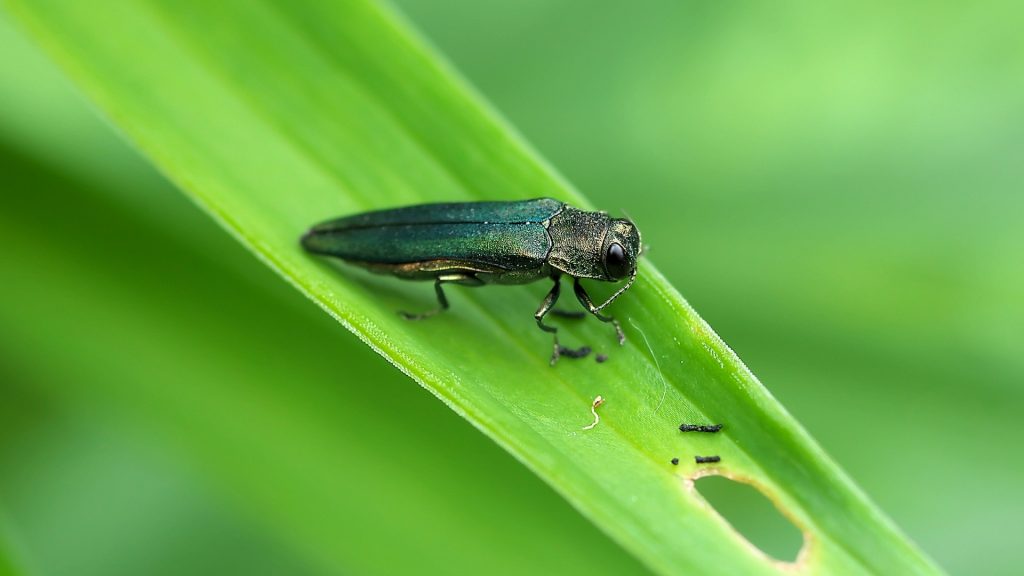
To treat trees with emerald ash borer, you can use special soil insecticides or trunk injections. Then, you will want to apply a borer spray all over the tree. The soil insecticides prevent the borer species from spreading further through the bottom of the trunk while the spray kills the active pests.
How To Get Rid of Pine Sawyer Beetles?
Pine sawyer beetles are very resistant to insecticides, so the only way to avoid them is through prevention. You will want to spray your trees regularly with a borer killer. Sadly, heavily infested trees will need to be cut down and burned to prevent the larvae from spreading.
If you find an infestation of pine sawyer beetles, you will need first to spray your uninfested trees, then remove the trees that have the borers. Once the trees are cut down, it’s best to burn them or spray them thoroughly with chemicals before throwing them away.
If you don’t use the proper disposal methods, the bugs can linger on your property and infect more trees. Before removing the infested trees, it helps if you spray the healthy ones with chemicals. That way, the disturbed larvae will not try to escape into another healthy tree.
How To Protect Your Tree From Borer Beetles?
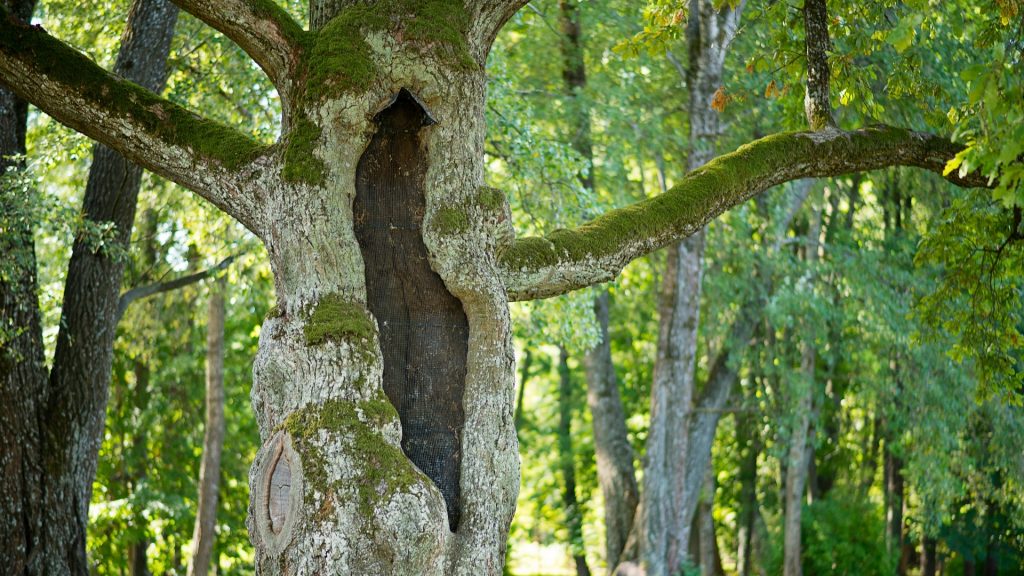
Most wood-boring insects are secondary invaders, which means the best way to protect your trees from them is to keep your trees as healthy as possible. You want to avoid accidentally causing stress to the trees by using fertilizer. Watering them more often can also help quite a lot.
Additionally, taking care of injured trees is essential. When beetles notice damaged branches and bark, they choose those areas to lay their eggs. You want to remove infested trees also since the insects can quickly move from one tree to another.
FAQ About Trees and Borer Beetles
What Bores Holes in Pine Trees?
Bark beetles are the most common boring insects when it comes to pines and spruce. They attack weakened pine trees across the country. You will notice small holes all over the trunk and some of the larger limbs when your tree is infected.
Are Mountain Ash Trees Susceptible to Ash Borer?
The emerald ash borer prefers all ash tree species except for the mountain ash tree. The mountain ash is a part of the rose family, meaning it is technically not a “real” ash tree. If you have this type of tree on your property, the bugs will likely spare it.
You may still want to spray your trees with insecticides if you are dealing with these pests. Prevention will help you deal with borers the best.
Why Do Emerald Ash Borer Only Attack Ash Trees?
The emerald ash borer tends to only seek out and attack certain ash trees that produce manuka oil from their bark, which is very attractive to this borer. You can use manuka oil to make emerald ash borer traps, which will help prevent the spread of the grub through your trees.
For more information on emerald ash borers, check out this video:
Summary
Controlling a borer beetle infestation can be difficult. But by using chemical sprays as a preventive measure, you can avoid this situation in the future. Make sure you properly dispose of any heavily infected trees to slow the spread of the bugs.
Overall, you want to check your trees often for signs of borer beetles. Keep an eye out for small holes and sawdust around the bases of the trunks. If you notice any symptoms in your trees, make sure you start treatment right away! The sooner you start, the more likely your trees are to survive.
Related: How To Get Rid of Black Beetle? | Black Beetle Control and Treatment
List of Sources
Ball, J. (2018). Insecticides for Protecting Pine Trees from Mountain Pine Beetle.
Brown, W. (n.d.). Wood-boring Beetles of Structures.
Drees, B. M., Jackman, J. A., & Merchant, M. E. (2019). Wood-boring Insects of Trees and Shrubs.
Potter, D. A., & Potter, M. F. (2016). Insect Borers of Trees and Shrubs.
- How to Get Rid of Cockroaches? | Proven Strategies & Solutions! - June 24, 2023
- Powerful Homemade Wasp and Bee Sprays (with Recipes) - March 4, 2023
- Crazy Ants Invasion | Eradicate & Prevent Unwanted Guests - February 24, 2023

